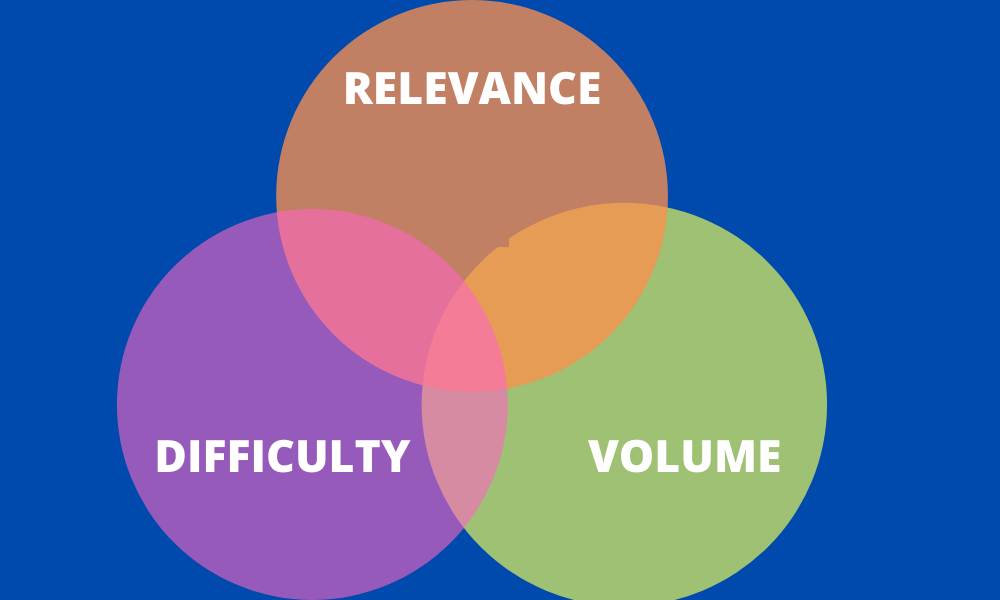The Top Proven Insider Strategies To Quickly Optimise Keywords On Your Website
The process of studying, analyzing, and selecting the best keywords in order to attract qualified traffic from search engines to your website is known as keyword optimization. And it is a significant factor for your website.
Keyword optimization improves your website’s traffic and quality of content. This requires the use of keyword updating tools. Understanding search intent and integration of keywords in the content are also crucial. This is achieved by including keywords in title tags, meta descriptions, and URLs, etc.
To a significant level, keywords also determine the social circulation of your article.
Which means…
It’s likely that even your best content will have a short-lived glory on social media. And then it’ll vanish off the face of the internet if you don’t use keywords properly.
In simple terms, you won’t be found if you don’t choose and employ keywords that your consumers are looking for.
So what’s my point?
Eventually, this implies a lack of traffic, sales, and revenue.
Key Benefits Of Keyword Optimization
So what exactly are the key benefits of keyword optimization?
Well there are multiple benefits. Essentially keyword optimization helps you in more than one way:-
1. Increase The Number Of Qualified Visitors To Your Website: To get people to come to your site, you need to optimize for the terms they’re looking for.
2. Calculate The Potential For Traffic: Some keywords are more popular than others. So you can exploit this popularity of keywords, and use them to estimate the size of a potential internet market.
3. Create Compelling Content: You can create great content only when you use keywords that add quality to the content. This way,you can also solve the problems of potential customers, thereby generating a followership.
4. Understand User Behaviour: You can know your consumers’ pain points by studying the keywords they use to search the internet.
Insider Strategies For Keyword Optimization
If you’re serious about polishing the art of keyword optimization, I recommend getting clear about the basics of keyword research.
Once you get that right, these highly effective insider strategies for keyword optimization will help:-
1. Firstly Don’t Begin With A List Of Keywords.
It’s best to be just human before you don your SEO hat.
Remember, customers can teach you a lot about your business. So before delving into tools and statistics, strive to gain a very good knowledge of your audience, and their viewpoints.
2. Create A List Of Seed Keywords.
Before you commence any production, you need raw material first.
And the same applies to keyword optimisation as well. So create an initial list of terms and phrases that effectively represent your main focus.
Based on what you learned in step one, you can collect keywords using some tried and tested keyword research strategies.
3. Tools For Updating Keyword Information.
It’s advisable to prepare a list of everything that is bringing traffic to your website.
Here are a few keyword ranking tools that can enable you to get updated keyword information
(1) Google Search Console. Google Search Console. It is a free Google service that allows you to track, maintain, and troubleshoot your site’s visibility in Google search results. It can help you better understand and optimize how Google sees your site. You don’t need to sign up for Search Console to appear in Google Search results.

(2) Ahrefs. Ahrefs is a well-known SEO tool that helps people improve their Google rankings. It’s a link-building, keyword-research, competitor-analysis software. And the majority of Ahrefs’ features are geared toward online marketing professionals.
(3)SemRush. SEMRush is an excellent toolkit for increasing web presence and uncovering marketing insights. It aids in the areas of SEO, PPC, SMM, keyword research, competitive research, PR, and content marketing.
(4) Moz Keyword Explorer. It’s a keyword research tool that helps you uncover profitable phrases and organize them into lists, saving you time. You can start by exploring what your potential clients could be looking for using Moz Keyword Explorer.
4. Keyword Analysis Tools To Enhance The Keywords List.
In addition to the above tools, you also need to search for additional keyword synonyms, similar terms, and long-tail variations. The following SEO keyword tools, in addition to the ones described above, are great for coming up with new ideas to add to your list:
(1) Answer The Public. AnswerThePublic obtains autocomplete data from search engines. It then uses this to instantly generate valuable phrases people ask. So it’s a keyword tool that visualizes search queries, and then suggests autocomplete searches.

This tool is extremely powerful and functions through simple questions like ‘how,’ ‘can,’ ‘are, ‘which’, and ‘will’.
(2) Keyword Tool.io. KeywordTool.io. is a free online keyword research tool that generates scores of relevant long-tail keywords for any topic using Google Autocomplete. It allows you to search through hundreds of results. The keyword recommendations are generated using the Google domain and language you provide.
(4)Keywords Everywhere. Keywords Everywhere (within Google search results) is a Firefox or Chrome extension for keyword research that users can install easily. Every keyword submitted in a Google Search may be checked for volume search, average CPC, and competition.
(5) KWFinder. KWFinder is a keyword research tool that aids in the discovery of long-tail keywords with a low SEO difficulty level.To begin using KWFinder, go to their website and sign up for a free account. A free subscription allows you to do three keyword searches and three SERP searches per day, with a limit of 50 related keyword recommendations per search. Keyword analysis, according to KWFinder, is not difficult. You only need keywords with low SEO difficulty and large search volume, and they will get you accurate search volumes and the most exact keyword difficulty.

(6)Infinite Suggest. Infinite Suggest is a free SEO tool that scrapes amazing Google autocomplete recommendations for you. It’s a high-powered keyword research tool with filtering and exporting capabilities. It obtains precise keyword data for Google autocompletion. With this free SEO tool, you may acquire an endless supply of Google keyword recommendations.
After you’re done selecting your keyword tools, you then need to work on the search intent.
5. Sort Terms Into Groups Based On Their Search Intent.
So how to you work on the keyword intent?
Essentially you need to sort your keywords into categories. You need to club them into groups that are easy to understand and effective for you.
This sounds tedious but it isn’t really.
You can actually simplify the process by creating groups according to audience type, topic, funnel phase, or any other method that makes sense to you.
Once you get the search intent right, it also helps you use keyword intent for generating conversions.
6. Create A Keyword-To-Content Map.
This is essentially getting methodical in your approach.
On each page, choose 2-3 primary keywords to target.Base it on a deliberate mix of keyword difficulty, relevancy, and search volume.

Once you find those, find semantically similar and long-tail keywords to support your main keywords.
Long-tail keywords, broadly speaking, are keyword terms that typically comprise four or more words.
But more importantly, long-tail keywords are distinguished by their “specificity,” rather than the number of words. They facilitate online searches by focusing on specifics and are extremely beneficial for low competition searches.
7. Don’t Just Repeat The Process But Iterate.
Earlier, website owners would simply wash, rinse and repeat once their keyword approach had been deployed, but that doesn’t work any longer.
Remember, Google is a huge fan of current, and useful information. The future of content is iterative.
Iteration implies you update your content so that freshness is always available to Google crawlers on your site.
Put another way, you’re failing if you’re not iteratively upgrading your content. Eventually, your competition will update their own content to make a better, more informed version if you neglect this aspect.
Keyword Placement On A Website
Once you’ve optimized your keywords, under the current SEO environment it is recommended that you use them in the first 150 words of your article.
Besides, there are additional crucial positions in your content where they should be placed to improve SEO.
1. Title Tags:
Title tags have an impact on rankings and click-through rate (CTR). And keywords can help with both if worded correctly. When your work is published online, your title tag becomes the clickable headline for readers. This indicates that your title tag is conveying useful information and that your page contains relevant information for your reader. So it’s advisable to include your keywords in your title tag.

2. Meta Description Tags:
The meta description is simply an HTML tag with roughly 160 characters. Visitors interpret the meta description as a snippet that briefly summarises the content of a web page. Before clicking on a link, Google provides a meta description in search results to let visitors know what the page is about. Unlike title tags, meta descriptions have no bearing on Google’s results. But including them can enhance the click-through rate (CTR).
3. URL Slug:
The URL of a web page on the internet is used to determine its address or the universal resource locator (URL). So, what exactly is a URL slug? The component of a URL that identifies a webpage in easy-to-read form is called a ‘slug.’ In the image below, the blue borders enclose a URL slug:-

To put it another way, it describes the content of the page. The URL slug, like the title tag, appears in SERPs. As a result, it’s best to keep your URLs as short as possible for the sake of “SEO “. URLs are clearly identifiable, rarely change, and represent the entire page. For these reasons, Google considers them super-valuable.
4. Static Content:
Search engines are improving their crawling capabilities for new content. Indexing is almost certain with static content. Static content is something that does not change or is not updated frequently. Your homepage, for example, might fall into this group. A sales page or an ebook/whitepaper are two further examples. Static web pages, in other words, are those that serve the same HTML code to all visitors.
5. Image Alt Attributes:
This is where you describe the image itself, but don’t overdo it with keywords. Make the alt tag as “black cat” if the image is of a black cat. The alt tag is designed to allow readers with vision impairments or who have images blocked on their browser, to see what the images are on the page are about. Besides the visually impaired visitors, they also help Google understand your image.
6. Internal Links And Content:
Using keywords in the anchor text of links pointing to your website helps Google understand what your page is about. Similarly, information around anchor text linking to your website is important to Google. In fact, it is utilized to define the destination page to a lesser extent.

7. Most Prominent Content:
It is Google’s responsibility to comprehend the content in the same manner that humans do. An H1 tag at the top of the article attracts significantly more attention than standardized information towards the bottom of the page. The most visible text, whether it’s a heading tag, a subheading, an image alt text, an anchor text, or a highlighted phrase, is usually the most influential for SEO.So the lesson is to use keywords in prominent places in the content, instead of wasting your keywords by distributing them over nooks and corners of your content.
8. Image And Video File Names:
You can let the internet give your image a random and meaningless name. Or you can give it a meaningful name that includes a relevant keyword. This way you can help the user by offering a better user experience. So make sure to mark images primarily for users, to improve your content’s visibility in Google Images. Also, ensure your visual content is related to the page’s topic.

9. Image Title Attributes:
Image titles may not work the same in all browsers, which is why Google may not give this content any weight. If there is an opportunity to integrate keywords in a tasteful manner, make use of it.
10. ARIA Tags:
ARIA stands for Accessible Rich Internet Applications. It’s a set of attributes that specify the method of making web content and web apps (particularly those built with JavaScript) more accessible to people with disabilities.ARIA tags can be used on dynamic content, interactive content, background pictures, and other forms of content.
11. Video Transcripts And/Or Closed Captioning:
Some videos contain incredibly relevant keywords, but Google has no idea. So in order to avoid that, make sure you include everything you hear and see in your indexable closed captions or transcripts.
12. Schema Markup:
Back in 2011, top search engines such as Google, Yahoo, Bing, and Yandex partnered to build Schema.org. And Schema markup is a type of microdata that can be found at Schema.org.Schema markup generates an enriched description (also known as a rich snippet) that displays in search results once it is added to a webpage.
Usually, people can understand the underlying meaning of your web pages when they read them.
However, search engines only have a weak grasp of the content on those pages. By incorporating additional tags into your web pages’ HTML. You can aid search engines and other applications in better understanding and displaying your material.
Integration Of Keywords
Keyword integration is the process of smoothly blending keywords into your content.
Remember, regardless of relevance, no one wants to read your content if it’s artificially crammed with keywords, and appears awkward sounding. So keyword integration ensures that the writer’s hard work in creating content pays off in the form of traffic and organic leads.
1. Don’t Overdo It: Over-optimization (also known as “keyword stuffing”) is a pretty common mistake.

It has the negative potential to turn away clients, and also the power to put you under penalty with Google’s Panda. Keyword stuffing is justifiably regarded as a black hat SEO approach that violates best practices.
2. Disregard The Meta Keywords Element: The meta keywords tag isn’t normally used by major search engines for SEO. Furthermore, employing the tag provides your competitors with a pre-packaged list of keywords you’re targeting, making it easier for them to compete with you. Therefore adding it is a waste of time and resources. So simply disregard it.
3. Don’t Optimise Each Page In Isolation: Unless you have a one-page site, you must ensure keyword targeting across all pages. This will prevent any gaps or keyword cannibalism that may occur if you work on each page separately.
Conclusion
Keywords when optimized, increase the number of qualified visitors to your website. That’s only possible once you optimize for the terms they’re looking for.
Keyword optimization also helps in calculating the potential for traffic, creating compelling content, and understanding user behavior.
A significant function of keyword optimization is also to collect updated keyword Information. For enhancing that list, you need to use various keyword analysis tools.
Above all, you have to make sure you integrate the keywords well into your content. This can be determined by your keyword placement on the website. This includes tactical positions like title tags, image alt attributes, internal links, static content, and URLs.
Because of perceived difficulty, most website owners, marketers, and bloggers do not devote enough attention to keyword optimization. Yet this is the very link in the chain that sets the stage for your eventual success or failure in blogging and internet marketing.

